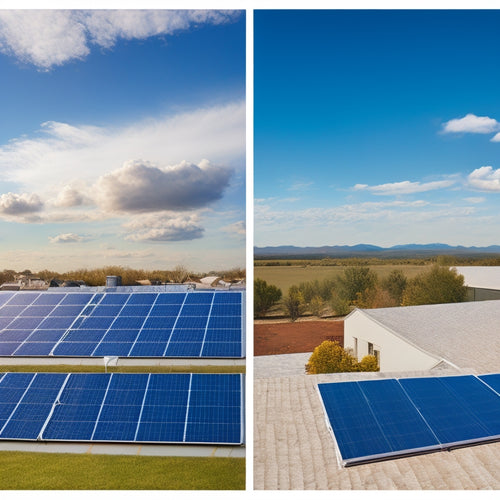
Cleaner Cities: Switch to a Greener Ride Today
Share
You can contribute to a cleaner, healthier, and more sustainable urban environment by switching to a greener ride today. Electric vehicles offer a cleaner, quieter, and more sustainable alternative to traditional gas-powered cars. By choosing an EV, you'll reduce your carbon footprint, eliminate noise and air pollution, and enjoy improved fuel efficiency. Urban planners are adapting to accommodate eco-friendly vehicles, and EV-friendly infrastructure and green spaces are emerging in urban landscapes. As you explore the world of electric vehicles, you'll discover how you can play a significant role in reducing air pollution and creating a healthier urban future - and that's just the start.
Key Takeaways
• Electric vehicles reduce carbon footprint, eliminating noise and air pollution from city streets for a cleaner urban future.
• Transitioning to EVs minimizes emissions, and pairing them with renewable energy sources reduces dependence on fossil fuels.
• Effective policies and regulations can reduce air pollution, and investing in public transportation improves air quality and reduces emissions.
• EVs produce zero emissions, reduce greenhouse gas emissions, and prioritize safety with lower operating costs and improved performance.
• Urban planners adapt infrastructure to accommodate eco-friendly vehicles, integrating EV-friendly infrastructure and green spaces for a sustainable future.
Electric Vehicles for Urban Futures
As you navigate the bustling streets of urban centers, you're likely to notice a growing presence of electric vehicles (EVs) zipping past, offering a glimpse into a cleaner, quieter, and more sustainable urban future. City dwellers are becoming increasingly environmentally conscious, and EVs are a significant step towards reducing the carbon footprint of urban landscapes.
With EVs, you can bid farewell to the noise and air pollution that have long plagued city streets. Imagine strolling through your city, breathing in fresh air, and enjoying the peaceful hum of electric motors.
As EVs become more mainstream, urban planners and policymakers are reimagining urban spaces to accommodate these eco-friendly vehicles. This shift is transforming the way we experience city living, with EV-friendly infrastructure and green spaces springing up across urban landscapes.
As you explore your city, you'll notice charging stations popping up in convenient locations, making it easier than ever to own and maintain an EV. The future of urban transportation is electric, and it's an exciting time to be a city dweller.
Breaking Free From Fossil Fuels
As you consider the future of transportation, it's clear that fossil fuels are a thing of the past.
You're likely aware that electric vehicles are gaining traction, and for good reason - they're a cleaner, more efficient alternative to traditional gas-powered cars.
Now, it's time to explore the benefits of ditching your gas guzzler and embracing an electric future.
Ditch the Gas Guzzler
You've likely heard the statistic that transportation accounts for nearly 27% of greenhouse gas emissions in the United States, with the majority of those emissions coming from fossil fuels. It's time to ditch the gas guzzler and switch to a greener ride. Not only will you be reducing your carbon footprint, but you'll also save money on fuel costs.
| Vehicle Type | Fuel Efficiency (mpg) | Road Tripping Range (miles) |
|---|---|---|
| Gas-Powered Sedan | 25-30 | 375-450 |
| Hybrid Sedan | 40-50 | 600-750 |
| Electric Vehicle | 100-120 | 250-300 |
When shopping for a new ride, consider fuel efficiency as a top priority. Hybrid and electric vehicles offer significant improvements over traditional gas-powered cars. Plus, they're perfect for road tripping, with many models offering ranges of over 500 miles on a single charge. By ditching the gas guzzler, you'll be contributing to a cleaner, healthier environment for future generations.
Electric Is the Future
By choosing electric vehicles, you're not only reducing your carbon footprint but also joining a growing movement that's rapidly phasing out fossil fuels from the transportation sector. You're becoming part of a revolutionary shift towards a cleaner, healthier environment. Electric vehicles are no longer just a niche choice; they're a mainstream solution for a sustainable future.
With Electric Dreams becoming a reality, you can drive away from the gas pump and into a Future Proof world. Imagine cruising through the city, knowing you're not contributing to air pollution or climate change. It's a liberating feeling, and it's within your grasp.
As more people make the switch, the demand for electric vehicles is driving innovation and reducing costs. You'll be amazed at how far electric vehicles have come, with impressive ranges, sleek designs, and advanced technology.
Clean Energy Now
One in five cars on the road could be running on clean energy by 2030, freeing our cities from the chokehold of fossil fuels. You're probably wondering how we can make this happen. The answer lies in Renewable Incentives and Energy Democracy.
Governments and companies are already working together to make clean energy more accessible. For instance, you can now lease an electric car for a lower monthly payment than a gas-guzzler. But we need more initiatives like these to accelerate the shift.
Here are a few ways you can contribute to the clean energy revolution:
-
Invest in renewable energy sources: Consider buying solar panels or investing in a community wind farm.
-
Support Energy Democracy: Advocate for policies that promote clean energy and reduce our reliance on fossil fuels.
-
Make conscious transportation choices: When possible, choose electric or hybrid vehicles, public transport, or even cycling or walking.
The Air Quality Imperative
As the world's population increasingly congregates in urban centers, the toxic soup of air pollutants swirling around you poses a notable threat to public health, making air quality improvement an urgent imperative.
You're not alone in this struggle; cities worldwide are grappling with the consequences of air pollution. It's estimated that 9 out of 10 people breathe polluted air daily, resulting in 7 million premature deaths annually.
City governance plays a critical role in addressing this issue. Effective policies and regulations can markedly reduce air pollution. For instance, implementing emission standards, promoting cleaner fuels, and investing in public transportation can make a substantial difference.
Additionally, encouraging alternative modes of transportation, like cycling or walking, can also contribute to cleaner air. As you navigate your daily commute, remember that the air you breathe is a shared responsibility.
How EVs Reduce Emissions
In switching to electric vehicles (EVs), you're not only upgrading your ride, but also slashing emissions that contribute to the toxic air pollution plaguing our cities. By choosing EVs, you're greatly reducing your carbon footprint, and that's a huge step towards a cleaner environment.
Here are just a few ways EVs reduce emissions:
-
Zero Tailpipe Emissions: EVs produce zero emissions while operating, eliminating the pollutants that contribute to air pollution in urban areas.
-
Energy Storage: EVs store energy in advanced batteries, reducing the dependence on fossil fuels and minimizing greenhouse gas emissions.
-
Renewable Energy Source: When paired with renewable energy sources like solar or wind power, EVs can operate almost entirely emission-free.
Greening City Streets Ahead
You're taking a major step towards greening city streets ahead by choosing EVs, and now it's time to explore the urban planning strategies that can amplify their environmental benefits.
As you drive your eco-friendly vehicle, you're not only reducing emissions but also contributing to a significant movement towards sustainable urban development.
City revitalization efforts can be supercharged by incorporating green spaces, pedestrian-friendly infrastructure, and smart traffic management. By doing so, cities can reduce congestion, improve air quality, and create more livable spaces for residents.
Urban landscaping plays an essential role in this process, as it helps to mitigate the urban heat island effect, absorb pollutants, and provide habitat for urban wildlife.
By integrating these strategies, cities can become more resilient, sustainable, and enjoyable for everyone.
As you cruise through the city in your EV, imagine the positive impact you're having on the environment and the community. You're part of a movement that's shaping the future of urban living.
The Rise of Sustainable Mobility
As you explore the future of transportation, you're likely wondering how cities can become cleaner and healthier.
The rise of sustainable mobility is revolutionizing the way we travel, and it's about time you learned about the innovative solutions that are transforming urban landscapes.
From electrifying roads to green urban infrastructure and sustainable commuting options, you're about to discover the exciting possibilities that are shaping the future of transportation.
Electrifying the Road Ahead
With the transportation sector accounting for nearly a quarter of global carbon emissions, electrifying the road ahead is essential for reducing our reliance on fossil fuels and creating a sustainable future.
As you consider making the switch to an electric vehicle (EV), you're not only contributing to a cleaner environment, but also opening yourself up to a world of benefits. For instance, you'll enjoy lower operating costs, reduced maintenance, and a smoother, quieter ride.
Here are just a few ways cities are supporting the shift to EVs:
-
Smart Charging: cities are implementing smart charging systems that optimize energy distribution, reducing strain on the grid and making it easier for you to charge your vehicle on-the-go.
-
Road Pricing: cities are introducing congestion pricing and low-emission zones to discourage fossil fuel-based transportation and encourage the adoption of EVs.
-
Incentives: many cities offer incentives, such as tax credits, rebates, and preferential parking, to encourage the adoption of EVs.
As you make the switch to an EV, you'll be joining a growing community of individuals committed to reducing their carbon footprint and creating a cleaner, healthier environment for future generations.
Greening Urban Infrastructure
Cities are transforming their urban landscapes to prioritize sustainable mobility, investing in green infrastructure that integrates eco-friendly transportation systems, pedestrian-friendly spaces, and green corridors to reduce emissions and enhance air quality.
As you step into this new urban environment, you'll notice the emphasis on green spaces, where trees and plants help purify the air and mitigate the urban heat island effect. Urban Forestry initiatives are taking root, with cities investing in tree-planting programs to create canopies that absorb pollutants and provide shade.
Meanwhile, Smart Grids are being implemented to optimize energy distribution, ensuring that your green ride is powered by renewable energy sources. You'll also notice the integration of green corridors, which not only beautify the cityscape but also provide natural habitats for local wildlife.
These innovative infrastructure upgrades are designed to create a healthier, more sustainable urban environment. As you explore these transformed cities, you'll experience the benefits of sustainable mobility firsthand – cleaner air, reduced congestion, and a more livable urban space.
Sustainable Commuting Options
You're now surrounded by a range of sustainable commuting options, from electric and hybrid buses to bike-sharing systems and pedestrian-friendly pathways, all designed to reduce your carbon footprint and make your daily commute a healthier, more environmentally friendly experience.
As you explore these options, you'll notice that cities are investing heavily in infrastructure to support sustainable mobility. This includes dedicated Bike Lanes, making cycling a safer and more appealing option. You can also take advantage of Car Sharing services, which reduce the number of privately owned vehicles on the road.
Some key benefits of sustainable commuting options include:
- Reduced air pollution and greenhouse gas emissions
- Increased physical activity and improved mental health
- Cost savings from reduced fuel consumption and parking fees
Cleaner Commutes for All
Every day, millions of commuters like you hit the roads, contributing to traffic congestion and air pollution, but what if there were a way to make your daily commute cleaner, healthier, and more sustainable? By adopting cleaner commutes, you can reduce your carbon footprint and improve air quality.
Community engagement is key to achieving this goal. Cities can promote urban equity by investing in public transportation, pedestrian-friendly infrastructure, and bike-share programs. This not only benefits the environment but also makes transportation more accessible and affordable for everyone.
Imagine having reliable, efficient, and eco-friendly options to get you to work, school, or wherever you need to go. By working together, we can create a more sustainable future, one commute at a time.
Electric Cars for a Healthier
By switching to electric cars, you'll not only reduce your carbon footprint but also breathe easier, as they produce zero tailpipe emissions, greatly decreasing air pollution in your community. This is especially important for those living in urban areas, where air quality can be particularly poor.
Not only do electric cars benefit the environment, but they also prioritize your safety. With a lower center of gravity due to the placement of batteries, electric vehicles are less likely to rollover. Additionally, they often come equipped with advanced safety features, such as automatic emergency braking and lane departure warning systems.
Some key benefits of electric cars include:
-
Reduced greenhouse gas emissions, contributing to a cleaner environment
-
Lower operating costs, saving you money on fuel and maintenance
-
Improved performance, with instant torque and smooth acceleration
Urban Planning for EV Adoption
As cities prepare for a surge in electric vehicle adoption, urban planners must rethink infrastructure to accommodate the unique needs of EV owners, guaranteeing a seamless and efficient charging experience. You, as a city dweller, will benefit from urban planning that integrates EV-friendly infrastructure.
This means reevaluating land use, urban density, and parking policies to prioritize EV charging stations. Bike lanes and pedestrian zones can be designed to complement EV charging areas, creating a harmonious and sustainable urban environment. Public spaces can be repurposed to incorporate EV charging points, making it convenient for you to charge your vehicle on-the-go.
Zoning laws and city ordinances will need to adapt to accommodate the growing demand for EV charging infrastructure. By doing so, cities can secure a smoother shift to an EV-dominated transportation system. As you navigate your city, you'll appreciate the thoughtfully designed infrastructure that supports your greener ride.
With urban planning that prioritizes EV adoption, you'll be driving towards a cleaner, healthier, and more sustainable future.
Frequently Asked Questions
Can I Charge My EV at Home With a Regular Outlet?
You can charge your EV at home with a regular outlet, but it's slow; consider a Home Installation of a 240-volt charger or Outlet Upgrades for faster charging, making your daily routine more convenient.
How Long Does It Take to Fully Charge an Electric Vehicle?
You're wondering how long it takes to fully charge your EV? Well, it depends on your car's battery capacity and the type of charging you use - Rapid Charging can fill up your battery to 80% in under 30 minutes!
Are Electric Vehicles More Expensive Than Gas-Powered Cars?
You're wondering if electric vehicles are more expensive than gas-powered cars? Well, it's true that luxury EV options can be pricey, but overall, the cost comparison shows EVs can be competitive, especially with lower operating costs.
Do Electric Vehicles Require More Maintenance Than Traditional Cars?
You'll be relieved to know that electric vehicles require less maintenance than traditional cars. You'll still need to perform routine tasks like battery checks and tire rotations, but overall, EVs have fewer moving parts, reducing maintenance needs.
Can I Take an Electric Vehicle on a Road Trip?
You're wondering if you can take your electric vehicle on a road trip? Absolutely! With some route planning and knowledge of charging networks, you'll be cruising to your destination in no time, worry-free!
Related Posts
-

Master Advanced Solar Panel Design Online for Free
You can master advanced solar panel design online for free by leveraging specialized courses and training platforms, ...
-

Top Online Stores for Solar Car Accessories
When searching online for solar car accessories, you'll find top retailers like Amazon, REI Co-op, and Best Buy offer...
-

Tracking Solar Panels Vs Fixed Panels Cost Savings
When considering solar panel options, you'll want to weigh the cost savings of tracking solar panels versus fixed pan...


